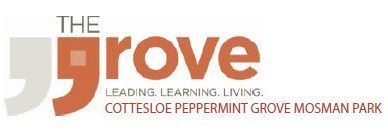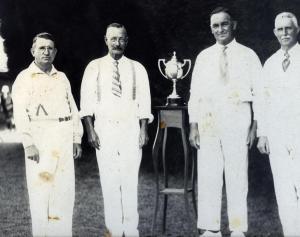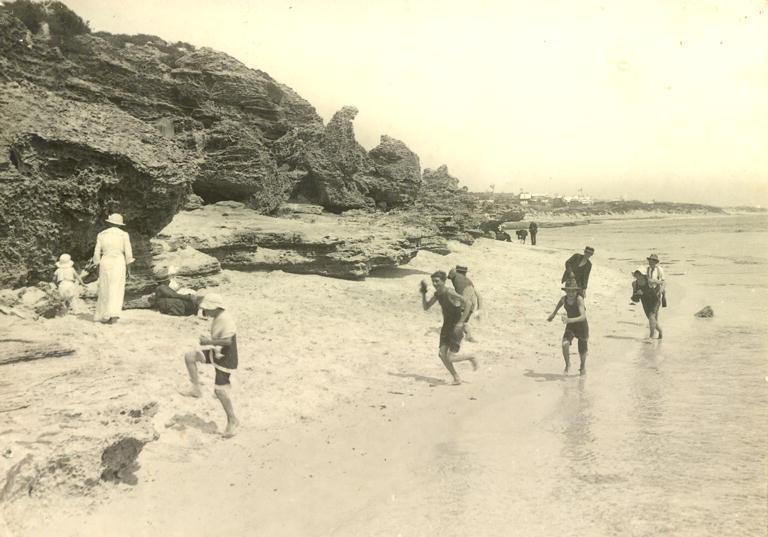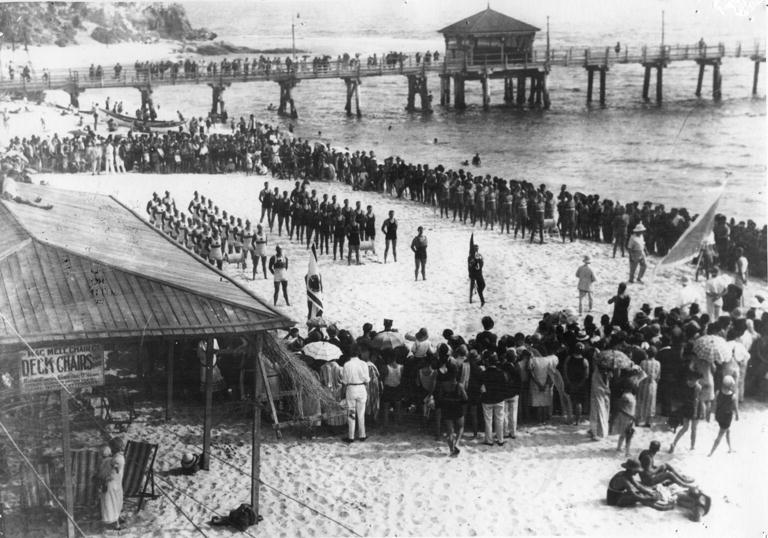The original owner of the land now known as Peppermint Grove was John Butler, who travelled to Australia with his wife Anne and brother Archibald in 1829. We knew that John owned a farm house along the old route to Perth which passed along current View Street but we didn’t know the exact location. Thanks to our intrepid volunteers (Rob and Sue Freeth), we can see both the original route and the location of John’s house and outbuildings. Rob manipulated the old map to align with current landmarks and contours so that we can see the locations more clearly. It is cleverly done….fascinating!
Albion Hotel and Stirling Highway
 Stirling Highway. Once known as the Perth to Fremantle road; its original route was a sandy bush track crossing Peppermint Grove and Freshwater Bay.
Stirling Highway. Once known as the Perth to Fremantle road; its original route was a sandy bush track crossing Peppermint Grove and Freshwater Bay.
To meet the demand for a resting place, original settler John Butler offered farmhouse accommodation for weary travellers at his Prospect Place property by the river in Peppermint Grove.
In the 1850s, when convict labour was being used to build roads, it was altered to follow its present route. Another Inn, Half Way House along the new route prospered but John’s business started to decline and John moved to Melbourne and rented out his property in Peppermint Grove. In 1872 Briggs acquired land surrounding the Half Way House and applied for a publican’s licence. Business was busy as the location was adjacent to a government reserve for teamsters. A place to park and quench your thirst. “how Australian”.
As traffic from Perth to Fremantle increased, first from teamsters with their loads of sandalwood, wool and limestone and then from coaches and cars – the road became a vital transport link.
Robert Napoleon Bullen bought the property in 1882 and set about further raising its profile. This was helped by the opening of the railway, and the station at ‘Bullen’s Siding,’ later Cottesloe. Bullen drew up plans for the Albion Hotel and Pleasure Grounds but died before they could be fully implemented.
In its day, the Albion Hotel was the starting and finishing point for competitive events of all kinds; including Perth Harriers, general athletics competitions, paper chases and hunts. Even pigeon shooting was an attraction. In 1884 a complaint was made about ‘the extremely unsportsmanlike way ‘in which pigeon shooting was conducted there.
The birds are so tame that they will not rise strongly from the trap. The gentlemen sportsmen then, instead of reserving their fire, at once bang away at the birds while sitting on the ground, or failing that, even at the trap itself.
In 1908 “the Albion” was sold to the Swan Brewery and still trades today in the heart of the Cottesloe community.
Missing names
Mudurup Rocks
Mudurup Rocks is the limestone promontory on the sea side of the Cottesloe Surf Club. The site is significant to the Nyungar people, and the name means “the place of the yellow finned whiting”. The associated shoreline to the south is said to be associated with the half-human, half-crow, known as Kudjil (the Crowman) who protected the Nyungars and announced to them when the fish would run and when the storms would arrive.
The area is now cared for by Cottesloe Coastcare.
Cottesloe Civic Centre
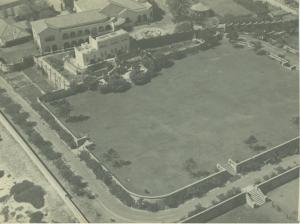 Cottesloe Civic Centre, located at 109 Broome Street, was built in 1889. It is a substantial two-storey, Inter-War Spanish Mission style house of rendered stone, brick and concrete with a tiled roof, a single-storey brick and tile hall, a single-storey brick and tile dwelling and substantial walled gardens.
Cottesloe Civic Centre, located at 109 Broome Street, was built in 1889. It is a substantial two-storey, Inter-War Spanish Mission style house of rendered stone, brick and concrete with a tiled roof, a single-storey brick and tile hall, a single-storey brick and tile dwelling and substantial walled gardens.
In its first form, the place was a substantial demonstration of the way of life of one of the State’s leading politicians. Under the ownership of Claude Albo de Bernales, the place became a demonstration of the way of life of a wealthy and flamboyant mining speculator and became a large scale symbol of his success and wealth.
The place has important associations with a number of eminent persons, including its first owner, the Hon. Mr Justice Pennefather, its second owner, Claude Albo de Bernales, Laurence Gadsdon, the Mayor of Cottesloe who oversaw the purchase of the place by the Town, architects Sir Bernard Evans, Samuel Rosenthal, Harold Boas and John Oldham, and several generations of Cottesloe councillors.
The transformation of the Federation Queen Anne style house, by then known as ‘Overton Lodge’, into an Inter-War Spanish Mission styled mansion, on a grand scale and to elegant effect, reflected a shift in popular domestic taste.
It is and has been accessible to the public for almost 50 years. With its pleasing streetscape setting, buildings, landscaping, large individual trees and limestone walls, the place is a familiar part of Cottesloe people’s existence and contributes to the community’s sense of place.
Taken from: Register of Heritage Places – Permanent Entry Cottesloe Civic Centre, 1997
Cottesloe Beach Hotel
The construction of Cottesloe Beach Hotel in 1905 formed part of the development of Marine Parade as a commercial precinct containing several hotels, guesthouses and tearooms in the early 1900s following the promotion and establishment of Cottesloe Beach as Western Australia’s prime recreational resort.
Cottesloe Beach Hotel demonstrates the development of hotels within the Perth metropolitan region both during the Gold Boom period and in the period of economic prosperity of the late 1930s following the Great Depression.
Constructed in 1905, Cottesloe Beach Hotel was one of the first beachside hotels in the Perth metropolitan area. The facades of Cottesloe Beach Hotel are a fine example of innovative design, which demonstrate considerable achievement in converting the 1905 hotel building using the Art Deco style in 1937.
The 1937 remodeling and substantial additions to Cottesloe Beach Hotel were designed by Hobbs, Forbes and Partners, a prominent Western Australian architectural firm. As well as being one of the most eminent architects in the State, partner JJ Talbot Hobbs was one of Western Australia’s highest ranking and most decorated soldiers in World War One.
Taken from: Register of Heritage Places – Cottesloe Beach Hotel, 2004
What’s in a name?
Ever wondered where the name Cottesloe came from?
Govenor Broome named Cottesloe in 1886 in honour of Captain Charles Fremantle’s elder brother, Thomas, the first Lord Cottesloe.
Cottesloe has Saxon origins being derived from the name “Cota” and “Lau” meaning “Hill”. The name Coteslau can be traced back to 1086. The name had changed to a name closely resembling the current spelling by 1776.
Ever wondered why there are so many Norfolk Pines in Cottesloe?
Norfolk Island Pines are a distinct feature of the suburb of Cottesloe. They provide a cool beautiful streetscape admired by all who view them. Their origin can be dated back to the early part of the 20th Century. The Cottesloe Roads Board in 1915 purchased 168 small Norfolk Island Pines in an effort to beautify the suburb. The 18 inch high saplings were planted along John Street and watered by the Board’s watering cart. Picket guards were placed around the trees to protect them from grazing cows, goats and horses which roamed the area and they were meticulously tended by Roads Board members William Zimpel and John Doscas who both lived in John Street. Both Zimpel and Doscas claim responsiblity for fostering the idea of planting Norfolk Island Pines. Doscas claiming he bought the idea from his homeland, the Greek Isles. Although there is evidence to support both parties the issue still remains unresolved. Image attached is CPM01311 John Street in 1937.
